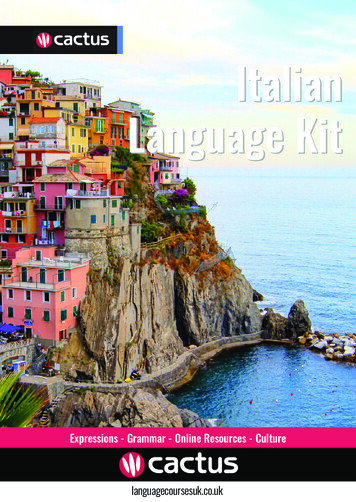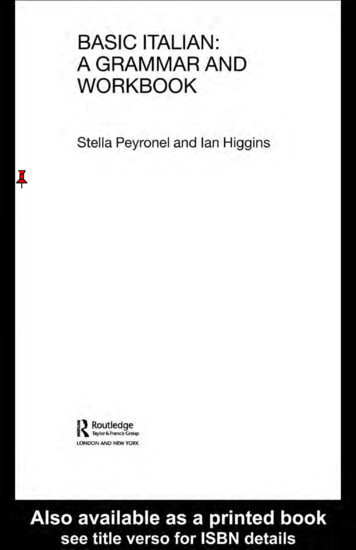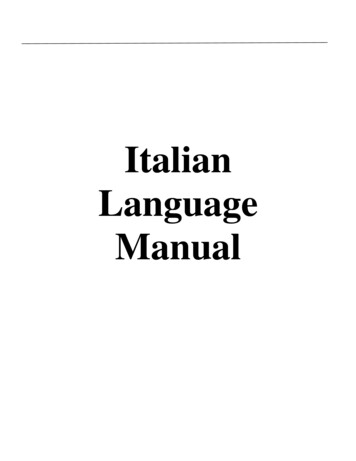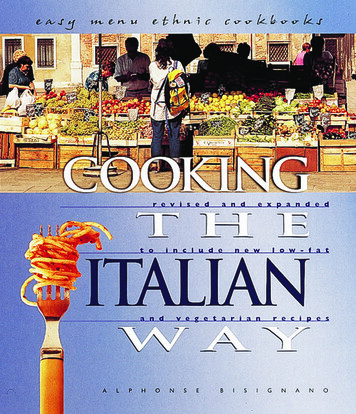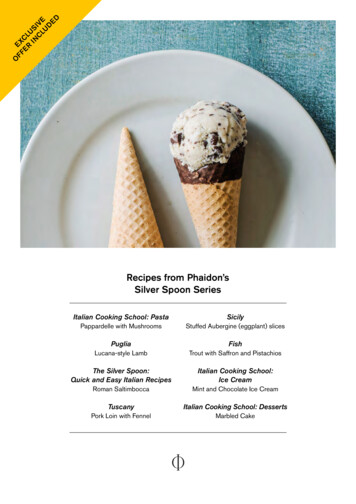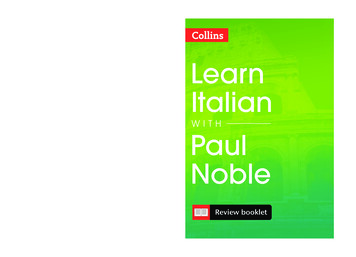
Transcription
This booklet provides you with a quick and easyway to review and reinforce what you have learnedduring your audio course. The booklet should beused after you have begun working through the CDsas it is not designed to teach you Italian by itself.LearnItalianWITHPaulNobleReview booklet
This booklet provides you with a quick and easyway to review and reinforce what you have learnedduring your audio course. The booklet should beused after you have begun working through the CDsas it is not designed to teach you Italian by itself.LearnItalianWITHPaulNobleReview booklet
Collins Learn Italian with Paul NobleHarperCollins Publishers77-85 Fulham Palace RoadHammersmithLondonW6 8JBwww.collinslanguage.comFirst published 2010Second edition 2012Reprint 10 9 8 7 6 5 4 3 2 1 0 HarperCollins Publishers 2011ISBN 978-0-00-736396-4All rights reserved.Edited by Caroline SmartTypeset by Marc MarazziProduced in China by Sony DADCOther languages in theCollins with Paul Noble series:French, Spanish and German
ContentsThe Paul Noble Method5Find out more about Paul, his unique method and why it makes learning Italianso very easy.How to use this bookletFind out how this booklet can help you as you progress through the course.7Creating Italian words8This is a light and fun way to begin your Italian review and expand your vocabulary inItalian. It will show you how to change various English words into Italian ones so that,by using this very simple tool, you can quickly develop an Italian vocabulary of severalthousand words – you will find it requires very little effort or time!Core course reviewHere you can review all the key structures and tenses you learnt during the coursein a quick and easy way.10The past11The present28The future40Travelling in ItalyThis is where you have a chance to use what you have learnt to deal withthose everyday situations you are likely to come across when travelling in Italy.46At the hotel47Finding a campsite48Taking a taxi to the piazza49At the piazza café49Eating out50At the tourist office / Finding the station52Noble Italian bklet internals.indd 330/05/2012 18:41
Taking a coach53Taking a train54Introducing yourself56A brief encounter57At the baker’s59Shopping at the market60At the pharmacy61Seeing a doctor62At a glance64Here you’ll find a quick snapshot of Italian numbers and the alphabet,to help round off your knowledge of Italian.Numbers64The alphabet66CD track listingNoble Italian bklet internals.indd 46730/05/2012 18:41
The Paul Noble MethodOver the years, I have taught many, many people. Curiously, they have each had muchthe same story to tell regarding their previous experiences of language learning. As aresult, these days, when I first start a teaching session, I ask my students to raise theirhands if they have had any of the following experiences.Raise your hand, I say: If you studied a language for several years at school but cameout unable to really say anything. If you have ever bought a language course and given up aroundpage thirty, somewhere around chapter two. If you have ever felt more confused by a teacher’s explanation ofthe language than by the language itself. If you have ever been amazed by just how closely grammarbooks resemble furniture assembly instructions. If you have ever felt that you may in fact be more or lessincapable of learning a foreign language.Invariably, all the students soon have at least one hand in the air – and they laugh.They laugh because for some reason our language-learning experiences tend to bevery similar and, sadly, these similar experiences tend not to be very good ones.My own initial experiences of language learning were also uncannily similar to thosedescribed above. In fact, when I ask my students these questions, my own hand is thefirst to go up – and it stays up until we have gone through them all.However, these less than positive experiences have had an upside both for myself andfor those individuals I have taught because they, along with a number of other factors,have helped inform and shape the method that will be used during this course.Using this method, you will learn how to communicate in Italian and how to formulateyour own ideas and thoughts using Italian.5Noble Italian bklet internals.indd 530/05/2012 18:41
The Paul Noble MethodAs you learn with it, you will quickly discover that I do not use complicated grammaticalexplanations at all, and I will not ask you to memorise long lists of vocabulary – the waythe course is structured will by itself ensure that you remember what you are taught.Instead, through your interaction with the CDs, I will lead you through the Italianlanguage, enabling you to build up complex sentences by yourself, step by step, so thatyou are actually speaking independently in Italian by the end of the course. And this isregardless of how little, or how much, you know when you begin.You will also discover that the language I teach is designed to be adaptable, so that youwill be able to use it just as easily for holidaying in Italy as for living or working there; itwill be just as easy to use it to order a coffee as to hold a conversation with the waiterwho brings it to you. And, again, all of this regardless of how little, or how much, youknow when you begin.At the time of writing, this method has already proved extremely successful with avery great many students, including hundreds of so-called “no-hopers”. Interestingly,not one of these students failed to learn using this method. It is these many successcases, letters of thank you – and even the occasional hug – that have made teachinglanguages so very worthwhile for me and it is this which has persuaded me to publishmy courses here, for the first time.I anticipate and hope that they will be as effective for you as they have been for somany of my other students.Paul NobleHead of the Paul Noble Language Institute6Noble Italian bklet internals.indd 630/05/2012 18:41
How to use this bookletThis booklet has been designed to provide you with a quick and easy way to review andreinforce the key vocabulary, structures and contents of your Paul Noble Method, EasyLearning Italian course.Although the core part of your learning will take place via your use of theaccompanying course CDs, we have also included this booklet in order to provide youwith a quick reference guide to the language, as well as a way to begin to get to gripswith both reading and writing Italian, should you wish to do so.It is worth noting that this booklet should be used after you have begun workingthrough the accompanying CDs. It will serve as excellent reinforcement, guidance andreview material but is not designed to teach you Italian by itself. This is what the CDswill do – and very rapidly too. After you have begun working through the CDs, you willfind this booklet to be an extremely useful review and reference resource but you muststart by listening to the CDs first.So, if you haven’t done so already, go and unwrap CD 1 and get started. You’re about tofind out just how good a course this is!7Noble Italian bklet internals.indd 730/05/2012 18:41
Creating Italian wordsUse these conversion techniques to create several thousand Italianwords out of English.Words ending in in Englishbecome in ileantanteimportanteelegantegalante8Noble Italian bklet internals.indd 830/05/2012 18:41
Creating Italian WordsWords ending in in Englishbecome in sivocorrosivo9Noble Italian bklet internals.indd 930/05/2012 18:41
Core course reviewThe best way to use this part of your booklet is to start by reading through a page,looking at both the English and Italian. Then go back to the beginning of that samepage and, while covering the Italian side of the text, translate the English into Italian –just as you did when you listened to the course CDs.Once you can get 90% of a page’s content correct, move on to the next page andfollow the process again. By doing this, you will quickly recall and reinforce what youlearnt with the CDs.10Noble Italian bklet internals.indd 1030/05/2012 18:41
The past (using “have”)I haveHoTo say “visited” in Italian, simply take the English word “visit” and then add the “ato”from “tomato” onto the end of it.visitedI have visitedRomeI have visited Rome.MilanI have visited Milan.You haveYou have visited Milan.You have visited Rome.visitatoHo visitatoRomaHo visitato Roma.MilanoHo visitato Milano.HaHa visitato Milano.Ha visitato Roma.NOTE! To ask a question in Italian, you simply raise your voice at the end of the sentence.Have you visited Rome?Have you visited Milan?preparedI have preparedthe coffeeI have prepared the coffee.I have prepared the coffee.Ha visitato Roma?Ha visitato Milano?preparatoHo preparatoil caffèHo preparato il caffè.Io ho preparato il caffè.NOTE! In Italian, the words for “I”, “he”, “she”, “you”, “we” and “they” do not always needto be included in a sentence in the way they would be in English. In fact, they tend to beleft out. If you do include one of these words, however, such as the word for “I”, which is io,it simply makes the sentence far more emphatic. The above two sentences demonstratethis, with the first stating simply that “I have prepared the coffee”, the second, by contrast,emphasises who made it. So, normally, you will not include the words for “I”, “he”, “she”,“you”, “we” or “they” unless you either want to make the sentence more emphatic orbecause you feel it might not be clear who you are referring to.11Noble Italian bklet internals.indd 1130/05/2012 18:41
The Past (using “have”)I have notI have not prepared the coffee.I have not prepared the coffee.Non hoNon ho preparato il caffè.Io non ho preparato il caffè.You haveYou have prepared the coffee.You have prepared the coffee.You have notYou have not prepared the coffee.You have not prepared the coffee.the risottoI have prepared the risotto.for youI have prepared the risotto for you.for meYou haven’t prepared the coffee for me.Haven’t you prepared the coffee for me?I have prepared the risotto for you.You haveHe hasShe hasHe has prepared the coffee for me.He hasHe has prepared the coffee for meHe has visited Rome.He has visited Rome.She hasShe hasShe has visited Rome.She has prepared the coffee for meShe has prepared the coffee for meShe hasn’t prepared (the) coffee for me.She hasn’t prepared (the) coffee for me.HaHa preparato il caffè.Lei ha preparato il caffè.Non haNon ha preparato il caffè.Lei non ha preparato il caffè.il risottoHo preparato il risotto.per LeiHo preparato il risotto per Lei.per meNon ha preparato il caffè per me.Non ha preparato il caffè per me?Ho preparato il risotto per Lei.HaHaHaHa preparato il caffè per me.Lui haLui ha preparato il caffè per me.Lui ha visitato Roma.Ha visitato Roma.HaLei haLei ha visitato Roma.Lei ha preparato il caffè per me.Ha preparato il caffè per me.Non ha preparato il caffè per me.Lei non ha preparato il caffèper me.12Noble Italian bklet internals.indd 1230/05/2012 18:41
The Past (using “have”)NOTE! Again, keep in mind that the Italian words for “I”, “he”, “she”, “you” etc will notnormally be included by Italians when they speak. Try to use them sparingly yourself,including them only when you want to make the sentence more emphatic or becauseyou feel it might not be clear who you are referring to.fatheryour fatherYour father hasn’t preparedthe coffee for me.motheryour motherYour mother has prepared(the) coffeefor me.padresuo padreSuo padre non ha preparatoil caffè per me.madresua madreSua madre ha preparatoil caffè per me.13Noble Italian bklet internals.indd 1330/05/2012 18:41
The Past (using “have”)Words that end in “ion”English words that end in “ion” came into English via Latin languages. There are 1250words that end in “ion” in English. With only a minor spelling change, you will find thatyou can use most of these words in Italian as parazionedecorazionepresentazioneformazioneGaining an instant thousand words or so in Italian is, of course, very helpful but thesewords can be even more useful than that.For instance, if you take an “ion” word, such as “preparation”, cut off the “ation” fromthe end of it, and in its place add the “ato” from “tomato”, you’ll end up with a wordlike preparato, which means prepared. Doing this, you can say I have prepared andusing the same technique you will also be able to say I have decorated, I have presentedetc. Try this with the examples below:preparationpreparazioneNow, cut off the “ation”, which leaves you with “prepar” and then add the “ato” from“tomato” on the end. You’ll end up with preparato, which means prepared.preparedI have preparedpreparatoHo preparatoLet’s try doing the same with the word “formation”. Cut off the “ation” from the endand replace it with the “ato” from “tomato”, which will give us formed – which will be:formedI have formedformatoHo formato14Noble Italian bklet internals.indd 1430/05/2012 18:41
The Past (using “have”)In English, we have the word “visitation”. Let’s try doing the same with this. Cut off the“ation” from the end and replace it with the “ato” from “tomato”, which will give usvisited – which will be:visitedI have visited Rome.the villaI have visited the villa.the piazzaI have visited the piazza.You have visited the piazza.He has visited the piazza.She has visited the piazza.They have visited the piazza.We have visited the piazza.We have visited the piazza.decorationdecoratedI have decoratedthe cake (the tart)I have decorated the cake.You have decorate the cake.Have you decorated the cake?I have decorated the cake.I decorated the cake.I did decorate the cake.visitatoHo visitato Roma.la villaHo visitato la villa.la piazzaHo visitato la piazza.Ha visitato la piazza.Ha visitato la piazza.Ha visitato la piazza.Hanno visitato la piazza.Abbiamo visitato la piazza.Noi abbiamo visitato la piazza.decorazionedecoratoHo decoratola tortaHo decorato la torta.Ha decorato la torta.Ha decorato la torta?Ho decorato la torta.Ho decorato la torta.Ho decorato la torta.NOTE! One of the best things about Italian, and one way in which it is easier thanEnglish, is that in order to talk about the past, you don’t need to use as many differenttenses as you would in English.For instance, take the following sentences in English: I have decorated the cake, Idecorated the cake, I did decorate the cake. In Italian, these are all expressed in the sameway, simply as: “I have decorated the cake”, which in Italian is: Ho decorato la torta.The above three sentences can therefore be served by the same single tense in Italian.15Noble Italian bklet internals.indd 1530/05/2012 18:41
The Past (using “have”)presentationpresentedI have presentedpresentazionepresentatoHo presentatoI have presented a petition.I presented a petition.I did present a petition.I decorated the cake.You have decorated the cake. (formal)You have decorated the cake. (formal)You have decorated the cake. (informal)You have decorated the cake. (informal)You have decorated the cake. (plural)You have decorated the cake. (plural)Ho presentato una petizione.Ho presentato una petizione.Ho presentato una petizione.Ho decorato la torta.Ha decorato la torta.Lei ha decorato la torta.Hai decorato la torta.Tu hai decorato la torta.Avete decorato la torta.Voi avete decorato la torta.NOTE! As you may have noticed above, there are several words that mean “you”in Italian.Lei means “you” when you are talking to just one person. It is the formal word for“you”, meaning that it is polite and is what you will use when you first meet someone;it is the most important one to learn.Tu is also used for talking to just one person but it is for use with family, close friendsand for talking to children. It is the informal word for “you”. English speakers often donot know when it is appropriate to start using tu with Italian speakers. The rule-ofthumb is: don’t use it first! Wait until a native speaker initiates it with you and then itshould be all right to use it back.Voi means “you” when you are talking to more than one person – it is the plural 1“you”. You can use this with any group of people, whether you know them well or not.From this point on in the booklet, any sentences involving “you” will mention whetheryou need to use the formal, informal or plural you.16Noble Italian bklet internals.indd 1630/05/2012 18:41
The Past (using “have”) JARGON BUSTER 1Plural means more than one of something.invitedI have invitedI have invited Paulto RomeI have invited Paul to Rome.I have invited Paul to Rome.He has invited Paul to Rome.He has invited your father to Rome.He has invited your father to Rome.She has invited your mother to Rome.She has invited your mother to Rome.reservation / pre-notationreserved / pre-notedI have reserved / pre-noted a rooma tableI have reserved a table.You have reserved a table. (formal)You have reserved a table. (formal)You have reserved a table. (informal)You have reserved a table. (informal)You have reserved a table. (plural)You have reserved a table. (plural)invitatoHo invitatoHo invitato Paul.a RomaHo invitato Paul a Roma.Io ho invitato Paul a Roma.Ha invitato Paul a Roma.Ha invitato suo padre a Roma.Lui ha invitato suo padre a Roma.Ha invitato sua madre a Roma.Lei ha invitato sua madre a Roma.prenotazioneprenotatoHo prenotato una cameraun tavoloHo prenotato un tavolo.Ha prenotato un tavolo.Lei ha prenotato un tavolo.Hai prenotato un tavolo.Tu hai prenotato un tavolo.Avete prenotato un tavolo.Voi avete prenotato un tavolo.17Noble Italian bklet internals.indd 1730/05/2012 18:41
The Past (using “have”)NOTE! It is important to note that all of the verbs 2 we have looked at so far areverbs that end in “are”: (to visit) visitare, (to prepare) preparare, (to invite) invitare.In the past tense, they have all become “ato”: visitato, preparato, invitato.90% of all verbs in Italian end in “are” and work in this way. The 10% that do not endin “are” work equally simply, however.For instance, verbs that end in “ire” in Italian become “ito” in the past tense. So,whereas for verbs that end in “are”, we replace the “are” on the end with the “ato”from “tomato”, for verbs that end in “ire” we instead simply replace their endings withthe “ito” from “mosquito”. JARGON BUSTER 2What is a verb? An easy way to identify a verb is to see ifyou can put “I”, “he” or “we” directly in front of it. If youcan, it is a verb. For example: I go, he eats, we fly, I buy, hethinks, we leave. All the underlined words are verbs; youknow this because you can put either “I”, “he” or “we”directly in front of them.Let’s have a practice with both types in order to better understand how they work.We will begin with those that end in “are”:to preparepreparedI have preparedto speakspokenWe have spokento buyWe have boughtItWe have bought it.prepararepreparatoho preparatoparlareparlatoAbbiamo parlatocomprareAbbiamo compratoLoLo abbiamo comprato.18Noble Italian bklet internals.indd 1830/05/2012 18:41
The Past (using “have”)NOTE! The word for “it” used in the sentence above is Lo. So, We have bought it isLo abbiamo comprato. However, before any word meaning “have” or “has”,you will find that the Lo is frequently contracted to a single, lone “L” by itself.So instead of Lo abbiamo comprato you will frequently find it pronounced andwritten as L’abbiamo comprato. Don’t worry too much about this, as both formsare equally acceptable.We haven’t bought it.They haven’t bought it.I bought it.Non l’abbiamo comprato.Non l’hanno comprato.L’ho comprato.Now let’s switch to those verbs that end in “ire”:to understandunderstoodcapirecapitoNOTE! Capire (to understand) does not end in “are” and so, as stated above, we havenot replaced the ending with the “ato” from “tomato” but rather with the “ito” from“mosquito”. Again, verbs ending in “are” in Italian replace the “are” at the end withthe “ato” from “tomato” but those that end in “ire”, such as capire, replace theirendings instead with the “ito” from “mosquito”.They have understood.They haven’t understood.They haven’t understood it.They haven’t understood it.They haven’t understood me.Haven’t they understood me?Hanno capito.Non hanno capito.Non l’hanno capito.Loro non l’hanno capito.Non mi hanno capito.Non mi hanno capito?19Noble Italian bklet internals.indd 1930/05/2012 18:41
The Past (using “have”)NOTE! Verbs that end in “ere” work differently still in the past tense. Whereas, forverbs that end in “are”, we replace the “are” with the “ato” from “tomato”, for verbsthat end in “ere” we replace their endings with the “uto” from “Pluto”.to sellsoldWe have soldWe have sold it.We haven’t sold it.We haven’t sold it.They haven’t sold it.Haven’t they sold it?venderevendutoAbbiamo vendutoL’abbiamo venduto.Non l’abbiamo venduto.Noi non l’abbiamo venduto.Non l’hanno venduto.Non l’hanno venduto?20Noble Italian bklet internals.indd 2030/05/2012 18:41
The past (using “to be”)Sometimes in Italian, you cannot use “have” for the past tense. Instead, you needto use a form of “to be” (am, is or are). This occurs when you use a verb 2 in the pastthat involves going or coming in any sense.So, when you are talking about going, coming, arriving, departing, going out, going up,coming down, being born (coming into the world) or dying (going out of it), you will use“to be” to form the past tense – not “have”.Therefore, to say in Italian that he has gone / he went you will literally say he is gone.To say she has arrived / she arrived you will say she is arrived. To say I have arrived /I arrived you will say I am arrived. This is, however, only for verbs that involve going orcoming in some sense. Let’s look at an example:I amto arrivearrivedI have arrived.We areWe have arrived.Sonoarrivarearrivato / arrivata / arrivati / arrivateSono arrivato / arrivata.SiamoSiamo arrivati / arrivate.Before moving on, it’s probably worth explaining why “arrived” is spelt in four differentways above – and sometimes in two different ways in a single sentence!Having worked your way through the course, understanding this will not actually be verydifficult because these changes in spelling work according to The Mario-Maria rule,which we used a great deal during the recorded part of the course. Let us remindourselves of how this works for a moment.21Noble Italian bklet internals.indd 2130/05/2012 18:41
The Past (without “to be”)The Mario-Maria ruleThe Mario-Maria rule states that male or masculine things in Italian tend to endwith an “o” – like the name Mario – but that female or feminine things tend to endwith an “a” – like the name Maria.In Italian, however, this affects more than just people’s names. For instance, it willaffect the spelling of the word “arrived”, as it has in the examples above.Let’s look at how a man would say I have arrived:I have arrived. (said by a man)Sono arrivato.Following The Mario-Maria rule, the word meaning “arrived”, when said by a man,ends with an “o”, just like the name Mario.But what do you think would happen if a woman tried to say the same thing, a Mariarather than a Mario? How would she say I have arrived?I have arrived. (said by a woman)Sono arrivata.As you can see, following The Mario-Mario rule, the word meaning “arrived”, whensaid by a woman, ends with an “a”, just as the name Maria does.Let’s try another example.to goI have gone. (said by a man)I have gone. (said by a woman)andareSono andato.Sono andata.As you can see, The Mario-Maria rule works in exactly the same way here as well.The female / feminine version ends with an “a” – like the name Maria – whereas themale / masculine version ends with an “o” – like the name Mario.22Noble Italian bklet internals.indd 2230/05/2012 18:41
The Past (using “to be”)As stated above, however, this only applies to “going and coming” verbs, because theseuse “to be” to make the past tense. Normal verbs, which use “have” to form the pasttense, are the same no matter who they refer to. The ends of the words will not changeno matter who is saying them. Take a look:I have prepared. (said by a man)I have prepared. (said by a woman)Ho preparato.Ho preparato.As you can see, they are the same – and they never change! It is only the small numberof verbs, which involve going or coming, and so which use “to be” to make the pasttense, that will change their spelling. Let’s look at these spelling changes, which workaccording to The Mario-Maria rule, one more time:I have gone. (said by a man)I have gone. (said by a woman)I have arrived. (said by a man)I have arrived. (said by a woman)Sono andato.Sono andata.Sono arrivato.Sono arrivata.23Noble Italian bklet internals.indd 2330/05/2012 18:41
The Past (without “to be”)The paparazzi ruleSo far we have looked at two different words that mean arrived – arrivato and arrivata.However, you may recall that, at the beginning of this section, there were originally fourwords used that each meant “arrived”. Let’s remind ourselves of these:arrivedarrivato / arrivata / arrivati /arrivateSo far we have looked at two of them, which work according to The Mario-Maria rule.Let us remind ourselves again of one of these examples:I have arrived. (said by a man)Sono arrivato.We therefore know how one man would say I have arrived. But what would the word for“arrived” be if there were more than one man? To answer this, we need to go back toThe paparazzi rule that we used during the recorded part of the course.The paparazzi rule states that, when there is a masculine word that ends in an “o”,that “o” becomes an “i” when there is more than one of that thing. Let’s look at anexample:a risottotwo risottosun risottodue risottiSo, we have a single risotto but two risotti – and we see this pattern repeated againand again in Italian:a paparazzitwo paparazzia biscottitwo biscottia paninitwo paninisun paparazzodue paparazziun biscottodue biscottiun paninodue panini24Noble Italian bklet internals.indd 2430/05/2012 18:41
The Past (without “to be”)This also applies to “arrived”. When one man has arrived, it will end with an “o” butwhen two have arrived it will end with an “i”.I have arrived. (said by one man)We have arrived. (said by two men)Sono arrivato.Siamo arrivati.Let’s try another example:I have gone. (said by one man)We have gone. (said by two men)Sono andato.Siamo andati.The same will happen with all verbs involving going and coming in Italian, when theyare used in the past tense.25Noble Italian bklet internals.indd 2530/05/2012 18:41
The Past (without “to be”)The A&E ruleWe now need to look at what two women will say in the same situation and for this wemust go to The A&E rule.The A&E rule states that, when there is a feminine word that ends in an “a”, that “a”on the end will become an “e” when there is more than one of that thing. Let’s look atan example:a pizzatwo pizzasuna pizzadue pizzeSo, we have a single pizza but two pizze – and we will see this pattern repeated againand again in Italian:a villatwo villasa piazzatwo piazzasuna villadue villeuna piazzadue piazzeThis also applies to “arrived”. When one woman has arrived, it will end with an “a” butwhen two have arrived it will end with an “e”.I have arrived. (said by a woman)We have arrived. (said by two women)Sono arrivata.Siamo arrivate.Let’s try another example:I have gone. (said by a woman)We have gone. (said by two women)Sono andata.Siamo andate.26Noble Italian bklet internals.indd 2630/05/2012 18:41
The Past (without “to be”)The Mario-Maria, Paparazzi and A&E rules puttogetherWe can now put these all together, safe in the knowledge that the past tense with “tobe” works in a very similar way to how one risotto becomes two risotti and how onepizza becomes two pizze.I have arrived. (said by a man)We have arrived. (said by two men)I have arrived. (said by a woman)We have arrived. (said by two women)I have gone. (said by a man)We have gone. (said by two men)I have gone. (said by a woman)We have gone. (said by two women)to leaveleftI have left. (said by a man)We have left. (said by two men)I have left. (said by a woman)We have left. (said by two women)Sono arrivato.Siamo arrivati.Sono arrivata.Siamo arrivate.Sono andato.Siamo andati.Sono andata.Siamo andate.partirepartito / partita / partiti / partiteSono partito.Siamo partiti.Sono partita.Siamo partite.NOTE! These changes are always dependent on who it is that has “arrived”, “gone”,“left” etc. Take a look at the examples below to understand this better.You are (formal)You have arrived. (said to a man)You have arrived. (said to a woman)You have gone. (said to a man)You have gone. (said to a woman)They areThey have arrived. (said about two men)They have arrived. (said about two women)They have gone. (said about two men)They have gone. (said about two women)ÈÈ arrivato.È arrivata.È andato.È andata.SonoSono arrivati.Sono arrivate.Sono andati.Sono andate.27Noble Italian bklet internals.indd 2730/05/2012 18:41
The presentUsing “It is”Words ending in “-ic”and “-ical” in English end in “-ico” in Italian.typicalexoticpoliticalIt isIt is typical!It is exotic!It is political!It is romantic!dramaticIt is dramatic!fantasticIt is fantastic!It is drastic!democraticIt is democratic!problematicIt is problematic!tipicoesoticopoliticoÈÈ tipico!È esotico!È politico!È romantico!drammaticoÈ drammatico!fantasticoÈ fantastico!È drastico!democraticoÈ democratico!problematicoÈ problematico!28Noble Italian bklet internals.indd 2830/05/2012 18:41
The PresentTalking about what you would
Learn This booklet provides you with a quick and easy Italian way to review and reinforce what you have learned during your audio course. The booklet should be . French, Spanish and German. Contents The Paul Noble Method 5 Find out more about Paul, his uniq
